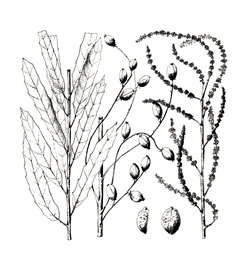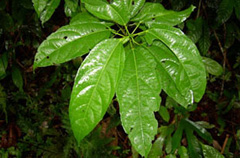 |
|
https://edibleplants.org/ |
 |
| oca-brazil.com |
Translate this page:
Summary
Iporuru.
Alchornea castaneifolia.
A medicinal plant known in South America, Iporuru (Alchornea castaneifolia) is a shrubby tree with an open crown and a straight, slender bole. It grows up to 8-10 m tall. It is known for its anti-inflammatory and pain relieving properties, and also widely used as an aphrodisiac and general tonic to the reproductive system. It has been used as a traditional medicine by the indigenous people of the Amazon where the bark and leaves are prepared in many different ways and are used for different purposes like remedies for rheumatism, arthritis, colds, and muscle pains. Indigenous people in Peru have used iporuru as remedy for osteoarthritis symptoms, and in aiding flexibility and range of motion. Tribes like Candochi-Shapra and the Shipibo Indian tribes use the plant?s bark and roots for treating rheumatism as well. Tikuna tribe, on the other hand, prevents diarrhea by taking one tablespoon of the plant?s bark decoction before meal. Iporuru?s leaves are crushed to relieve joints pain, and beaten into a paste to relieve pain from stingray wounds. Other names: Iporuru, Iporoni, Iporuro, Ipururo, Ipurosa, Macochihua, Niando, Pajaro
Physical Characteristics

 Alchornea castaneifolia is an evergreen Tree growing to 8 m (26ft) by 8 m (26ft) at a fast rate.
Alchornea castaneifolia is an evergreen Tree growing to 8 m (26ft) by 8 m (26ft) at a fast rate.
See above for USDA hardiness. It is hardy to UK zone 10.
Suitable for: light (sandy), medium (loamy) and heavy (clay) soils. Suitable pH: mildly acid, neutral and basic (mildly alkaline) soils and can grow in very acid soils.
It can grow in semi-shade (light woodland) or no shade. It prefers moist or wet soil.
UK Hardiness Map
US Hardiness Map
Synonyms
Alchornea passargei Pax & K.Hoffm. Hermesia castaneifolia Humb. & Bonpl. ex Willd. Hermesia salicifo
Plant Habitats
Edible Uses
References More on Edible Uses
Medicinal Uses
Plants For A Future can not take any responsibility for any adverse effects from the use of plants. Always seek advice from a professional before using a plant medicinally.
Anodyne Antiarthritic Antidiarrhoeal Antifungal Antiinflammatory Antirheumatic Antitumor Antiviral
Aphrodisiac Tonic
Iporuru has a high reputation as a medicinal herb in parts of S. America, though it is little known elsewhere. The bark and leaves are used for many different purposes and are prepared it in many different ways. However, it is especially valued for its anti-inflammatory and pain relieving properties and is also widely used as an aphrodisiac and general tonic to the reproductive system. It is commonly used with other plants during shamanistic training and, sometimes, is an ingredient in ayahuasca (a hallucinogenic, multi-herb decoction used by South American shamans)[ 318 ]. The plant has been shown to contain steroids, saponins, phenols, flavonols, flavones, tannins, xanthones, and alkaloids[ 318 ]. The anti-inflammatory properties are attributed to a group of alkaloids, including one called alchorneine, which are found in the bark of this and several other members of the genus[ 318 ]. There has been little clinical research on the plant - despite its long history of use. That which has been done, however, does help explain some of its traditional uses. An ethanol extract of the stembark has been shown to reduce swelling and inflammation when applied topically. This extract also inhibits prostaglandin synthesis - these prostaglandins are linked to inflammatory processes and diseases and the inhibitory activity may, in part, explain the traditional use of Iporuru for treating inflammatory joint and muscle disorders such as osteoarthritis, arthritis, and rheumatism318]. Other research has supported Iporuru's antifungal, antiviral, and antitumor activities[ 318 ]. An ethanol extract of the herb has proved to be much more effective than a water extract[ 318 ]. A tincture of the bark or leaves is used as a treatment for rheumatism, arthritis, colds, and muscle pains. It relieves the symptoms of osteoarthritis, and aids flexibility of the joint and range of motion. A decoction of the bark is taken before meals to prevent diarrhoea[ 318 , 558 ]. The crushed leaves are anodyne. They are rubbed on painful joints and are beaten into a paste to apply to painful stingray wounds[ 318 ]. A decoction of the leaves is used as a treatment for coughs. The leaves are used to increase female fertility (mostly in cases where the male is relatively impotent). It is widely used as an aphrodisiac and geriatric tonic for males and is regarded as a remedy for impotency as well as for balancing blood sugar levels in diabetics. The plant has been gaining popularity among North American athletes and health practitioners recently; with reports suggesting that it provides nutritional support to muscle and joint structures[ 318 ].
References More on Medicinal Uses
The Bookshop: Edible Plant Books
Our Latest books on Perennial Plants For Food Forests and Permaculture Gardens in paperback or digital formats.

Edible Tropical Plants
Food Forest Plants for Hotter Conditions: 250+ Plants For Tropical Food Forests & Permaculture Gardens.
More

Edible Temperate Plants
Plants for Your Food Forest: 500 Plants for Temperate Food Forests & Permaculture Gardens.
More

More Books
PFAF have eight books available in paperback and digital formats. Browse the shop for more information.
Shop Now
Other Uses
Fuel Wood
Other uses rating: Low (2/5). Other Uses: The thin layer of heartwood is greyish to dull chocolate brown; the sapwood is a lustrous pale brown with a greyish cast. The wood is straight-grained; medium-textured; light in weight and soft. It has no distinctive taste or odour[ 453 ]. The wood is used for fuel[ 453 ].
Special Uses
References More on Other Uses
Cultivation details
The plant can withstand seasonal inundation[ 318 ]. Iporuru can be harvested only in the Amazon's dry season; it spends the rainy season underwater. The locals believe that the active medicinal properties found in the bark are present only during the dry season[ 318 ].
References Carbon Farming Information and Carbon Sequestration Information
Temperature Converter
Type a value in the Celsius field to convert the value to Fahrenheit:
Fahrenheit:
The PFAF Bookshop
Plants For A Future have a number of books available in paperback and digital form. Book titles include Edible Plants, Edible Perennials, Edible Trees,Edible Shrubs, Woodland Gardening, and Temperate Food Forest Plants. Our new book is Food Forest Plants For Hotter Conditions (Tropical and Sub-Tropical).
Shop Now
Plant Propagation
Seed
Other Names
If available other names are mentioned here
Iporuru, Iporoni, Iporuro, Ipururo, Ipurosa, Macochihua, Niando, Pajaro
Native Range
SOUTHERN AMERICA: Venezuela, Brazil (Amazonas, Bahia, Maranhão, Mato Grosso, Pará), Bolivia, Colombia, Peru (Huánuco, Loreto, San Martín, Ucayali), Argentina (Formosa), Paraguay
Weed Potential
Right plant wrong place. We are currently updating this section.
Please note that a plant may be invasive in one area but may not in your area so it's worth checking.
None Known
Conservation Status
IUCN Red List of Threatened Plants Status : This taxon has not yet been assessed.

Growth: S = slow M = medium F = fast. Soil: L = light (sandy) M = medium H = heavy (clay). pH: A = acid N = neutral B = basic (alkaline). Shade: F = full shade S = semi-shade N = no shade. Moisture: D = dry M = Moist We = wet Wa = water.
Now available:
Food Forest Plants for Mediterranean Conditions
350+ Perennial Plants For Mediterranean and Drier Food Forests and Permaculture Gardens.
[Paperback and eBook]
This is the third in Plants For A Future's series of plant guides for food forests tailored to
specific climate zones. Following volumes on temperate and tropical ecosystems, this book focuses
on species suited to Mediterranean conditions—regions with hot, dry summers and cool, wet winters,
often facing the added challenge of climate change.
Read More
Expert comment
Author
(Humb. & Bonpl. ex Willd.) A.Juss.
Botanical References
1
Links / References
For a list of references used on this page please go here
A special thanks to Ken Fern for some of the information used on this page.
Readers comment
| Add a comment |
|
If you have important information about this plant that may help other users please add a comment or link below. Only comments or links that are felt to be directly relevant to a plant will be included. If you think a comment/link or information contained on this page is inaccurate or misleading we would welcome your feedback at [email protected]. If you have questions about a plant please use the Forum on this website as we do not have the resources to answer questions ourselves.
* Please note: the comments by website users are not necessarily those held by PFAF and may give misleading or inaccurate information.
To leave a comment please Register or login here All comments need to be approved so will not appear immediately.
|
Subject : Alchornea castaneifolia
|
|
|
|